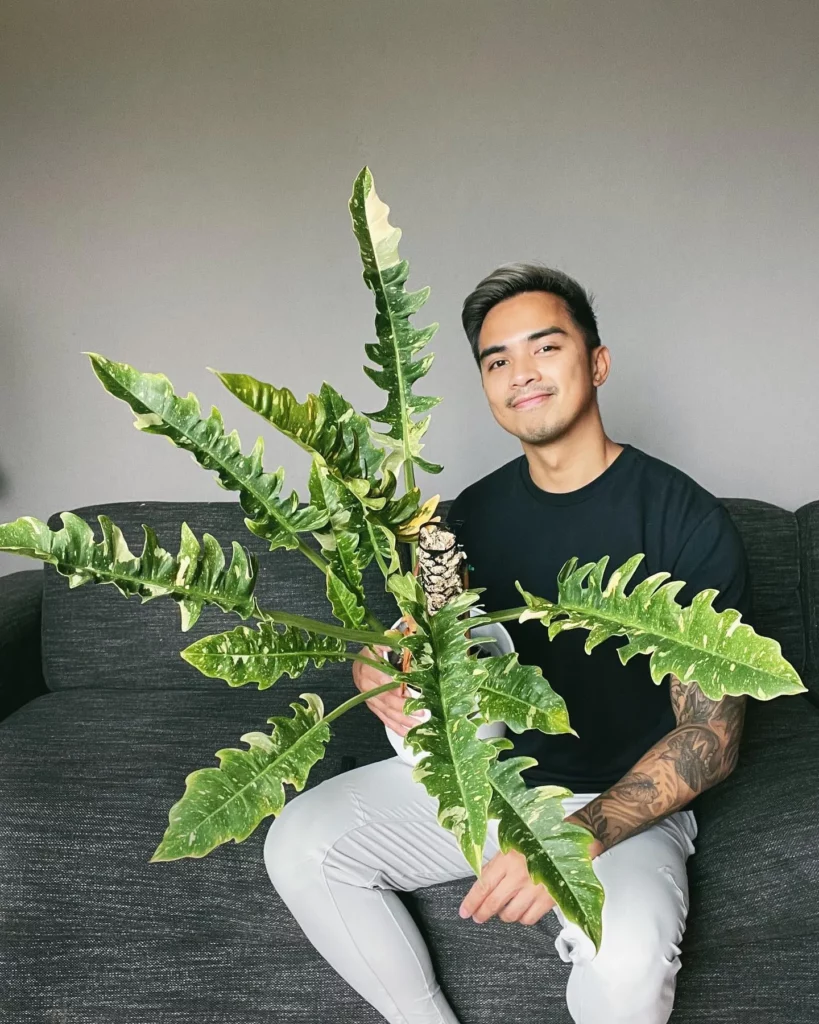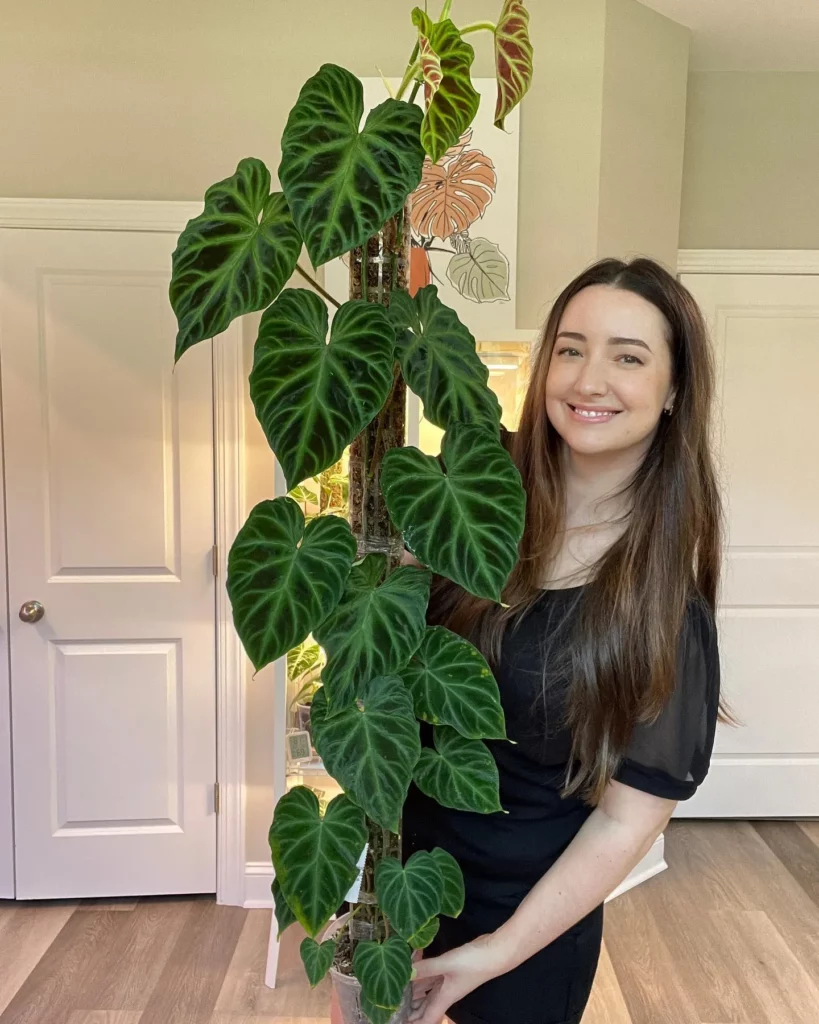Philodendrons typically require about 4-6 hours of indirect sunlight each day to thrive.
Sunlight is essential for philodendron growth and well-being. These tropical plants thrive in bright, indirect sunlight, using it for photosynthesis to generate energy for growth. Without enough sunlight, philodendrons may weaken and grow poorly. Additionally, sunlight helps regulate their internal temperature, ensuring they stay within an optimal range for healthy development, as extreme temperatures can be detrimental to their growth and survival.
An Overview Of How Much Sun Philodendrons Need



Now that you understand why sunlight is so important for philodendrons let’s talk about how much sun they need. As I mentioned earlier, these tropical plants love bright but indirect light. This means they should be placed near a window or outside where they can receive filtered light.
Direct sun exposure can scorch the leaves and damage the plant irreversibly. It might seem like common sense but trust me; many people make this mistake.
No products found.
Philodendrons also prefer consistent conditions when it comes to light exposure as changing too much will stress them out leading them to lose leaves and become unhealthy quickly. Find them a spot in your home where they receive the same amount of light every day, or if outside, try to avoid placing them in areas with excessive shade or full sun.
High-Level Overview

Types Of Philodendrons And Their Sun Requirements
Philodendrons come in many different types, each with unique sunlight requirements. Some prefer bright, direct sunlight while others thrive in more indirect light.
The Philodendron Selloum, for example, is a plant that can tolerate full sun but also grows well in partially shaded areas. Meanwhile, the Philodendron Micans requires no direct sunlight at all and will happily grow under the cover of other plants.
It’s important to research the specific type of philodendron you have to determine its sunlight needs. Don’t just assume that all philodendrons have the same sun requirements.
No products found.
General Guidelines For Sunlight Exposure
As a general rule, philodendrons prefer bright but indirect light. Direct sunlight can scorch the leaves and cause irreversible damage to the plant. However, if your philodendron is kept too far away from a source of light it may become leggy or fail to produce new growth.
To strike a balance between these extremes, try placing your philodendron near a window where it will receive bright but filtered light throughout most of the day. If you don’t have access to natural light or if your indoor space is particularly dark, consider using artificial grow lights to supplement your philodendron’s sun exposure.
Bright Vs Indirect Sunlight: Which Is Best?



As a plant expert, I have seen many people make the mistake of assuming that all plants need direct sunlight in order to survive. This is simply not true, and philodendrons are an excellent example of this.
While some philodendrons can handle some direct sunlight, most do best with bright, indirect light. So what exactly is the difference between bright and indirect sunlight?
Bright light refers to when the sun’s rays are shining directly onto the plant, while indirect light refers to when the plant is receiving light from a source other than the sun (such as a nearby window or lamp). For philodendrons, it’s important to keep them out of direct sunlight because their leaves can burn easily under intense heat.
No products found.
Bright Light
Philodendrons that are able to tolerate bright light typically have thicker leaves than those that require only indirect light. These types of philodendrons include species such as Philodendron selloum and Philodendron bipinnatifidum. These plants prefer a location with plenty of natural light but where they won’t be exposed to prolonged periods of direct sun.
Indirect Light
Most philodendrons prefer indirect light because their leaves are thin and delicate. They will thrive in areas where they receive bright but not harshly direct sunlight – for example near a north-facing window or beneath an overhanging tree outside.
The Impact Of Seasonality On Sunlight Needs

Many people assume that indoor plants require less care than outdoor plants since they’re sheltered from the elements. However, even indoor plants like philodendrons may have different needs depending on the season.
During summer months when days are longer and brighter, you should adjust your plant’s placement so it receives more shade during the hottest part of the day. During winter months, you may need to move your philodendron closer to a window or under a grow light to ensure it’s receiving enough light.
No products found.
How To Adjust Light Exposure For Indoor Vs Outdoor Philodendrons



Philodendrons can be grown both indoors and outdoors, and it’s important to adjust their light exposure accordingly. Here are some tips for growing philodendrons in different environments:
Indoor Growing
When growing philodendrons inside, make sure they’re placed near windows that receive plenty of bright but indirect sunlight. If you don’t have access to natural light sources, consider using artificial lighting (such as grow lights) to supplement your plant’s needs.
Outdoor Growing
In outdoor settings, choose a spot that receives bright but indirect sunlight throughout the day. Most philodendrons thrive in partial shade or dappled sunlight beneath larger trees.
If planting in full sun areas where temperatures rise above 85 F (29 C), provide filtered or dappled shade during peak daytime hours of heat between noon and 4 p.m. When it comes down to it, knowing how much sunlight your philodendron needs is key to keeping it healthy and happy.
No products found.
The Role Of Leaf Color In Determining Sun Requirements

The color of a plant’s leaves is a dead giveaway to its sun requirements. A philodendron with dark green leaves requires less sunlight than one with lighter green or variegated leaves.
This is because darker leaves contain more chlorophyll, which allows them to photosynthesize efficiently in low light conditions. If you have a philodendron with pale or yellowing leaves, it’s a sign that it needs more sunlight.
On the other hand, if the leaves are turning brown and crispy, it’s an indication of overexposure to sunlight. So pay attention to your plant’s leaf color and adjust its light exposure accordingly.
It’s also worth noting that some philodendrons naturally have dark green leaves regardless of their sun requirements. In these cases, look for other signs of overexposure or underexposure such as wilting or drooping foliage.
How To Identify Signs Of Overexposure Or Underexposure To Sunlight



Overexposing your philodendron to sunlight can lead to scorching and browning of the foliage. On the other hand, too little sun exposure can cause pale yellowing leaves and stunted growth. The key is finding the right balance.
Keep an eye on your plant and look for signs like wilting or drooping foliage which indicate that it may not be getting enough water or light. If you notice brown spots on the leaf tips, it could be due to too much direct sunlight exposure.
To make sure your philodendron is getting enough light, move it closer to a window or artificial light source if necessary. But be careful not to expose it directly under the sun for extended periods as this can harm even plants that require full sunlight.
No products found.
The Impact Of Soil Moisture On Sunlight Absorption

Soil moisture is crucial for any plant’s growth and development, including philodendrons. But did you know that it also plays a role in how your plant absorbs sunlight? When the soil is too dry, the philodendron’s roots cannot absorb nutrients efficiently which can lead to stunted growth.
In turn, this can affect its ability to photosynthesize which means it won’t be able to make use of the sunlight. On the other hand, if the soil is too moist it can lead to root rot which can damage the roots and cause other problems.
No products found.
To maintain optimal soil moisture levels, water your philodendron regularly but make sure not to overwater it. Allow the top layer of soil to dry out between watering sessions and make sure that there is good drainage in place.
The Verdict



Sun exposure is crucial for any plant’s survival, but finding the right balance for your philodendron can be tricky. Keep an eye on its leaf color and look out for signs of overexposure or underexposure like brown spots or yellowing leaves.
Remember that soil moisture plays a role in light absorption as well so be sure not to overwater your plant or let its roots dry out completely. With these tips in mind, you’ll be able to keep your philodendron thriving and looking gorgeous all year round!
Frequently Asked Questions
Philodendrons generally prefer bright, indirect light rather than direct sunlight. While they can tolerate some morning or evening sun, direct sunlight can be too intense and cause leaf burn or damage to the plant. It is best to place philodendrons in locations with filtered or diffused light, such as near a window with a sheer curtain or in a well-lit room without direct sun exposure.
Yes, philodendrons can be adversely affected by excessive light exposure. While they thrive in bright, indirect light, too much direct sunlight can lead to sunburn and scorched leaves. Symptoms of excessive light exposure include yellowing or browning of leaves and leaf curling. If you notice these signs, it is advisable to move the philodendron to a location with less intense light or provide shading to protect it from excessive sun.
When deciding on the placement of your philodendron indoors, it is best to choose a spot that offers bright, indirect light. East-facing or west-facing windows are often suitable as they provide moderate sunlight without direct exposure. You can also place your philodendron a few feet away from a south-facing window or use sheer curtains to filter the light. Avoid placing the plant in areas with drafts or extreme temperature fluctuations.
While philodendrons prefer bright, indirect light, they can tolerate some degree of shade. However, full shade conditions might not be ideal for their growth and can result in leggy or weak growth. If you intend to grow a philodendron in full shade, make sure the area still receives bright, indirect light, such as from a nearby window or through the use of artificial grow lights. Supplemental lighting can help compensate for the lack of natural sunlight and promote healthier growth.
After reading this, check out our other articles on:
Conclusion

Final Thoughts and Recommendations:
Philodendrons are beautiful tropical plants that can add a touch of greenery and life to any space. However, it is important to remember their specific sun requirements in order to keep them healthy and thriving.
Whether you’re caring for an indoor or outdoor plant, there are several ways you can adjust their light exposure accordingly. In addition to monitoring sunlight levels, make sure your philodendron is getting adequate water and nutrients as well.
Proper care will help ensure that your plant stays healthy for years to come. So, go ahead and add a philodendron to your home or office space – just make sure to give it the right amount of sunlight and love!





